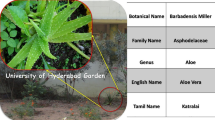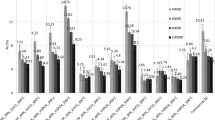Abstract
Herein, a novel polyaniline-decorated lignocellulose composite adsorbent made by modifying macadamia nutshells (MNS) with polyaniline (PANI) for the uptake of Cr(VI) is reported. The as-synthesised MNS–PANI was characterised using Fourier transform infrared spectroscopy, X-ray diffraction analysis, thermogravimetric analysis, field emission scanning electron microscopy, energy-dispersive X-ray analysis, transmission electron microscopy and Brunauer–Emmett–Teller surface area analysis. Batch adsorption experiments were carried out to investigate the adsorptive behaviour of MNS–PANI with Cr(VI). The uptake of Cr(VI) was well described by a pseudo-second-order kinetics model, while the adsorption isotherm best fitted the Langmuir model with a maximum adsorption capacity of 384.6 mg/g at 45 °C. Thermodynamic parameters obtained revealed endothermic and spontaneous uptake of Cr(VI) by MNS–PANI. The spent adsorbent was further applied for the photocatalytic degradation of ciprofloxacin, and 86% of the pharmaceutical was efficiently degraded within 80 min.













Similar content being viewed by others
References
Priya AK et al (2022) Investigation of mechanism of heavy metals (Cr6+, Pb2+& Zn2+) adsorption from aqueous medium using rice husk ash: kinetic and thermodynamic approach. Chemosphere 286:131796
Aryee AA et al (2022) Magnetic biocomposite based on peanut husk for adsorption of hexavalent chromium, congo red and phosphate from solution: characterization, kinetics, equilibrium, mechanism and antibacterial studies. Chemosphere 287:132030
Thangagiri B et al (2022) Removal of hexavalent chromium by biochar derived from azadirachta indica leaves: batch and column studies. Chemosphere 286:131598
Zhou H et al (2022) Sodium citrate and biochar synergistic improvement of nanoscale zero-valent iron composite for the removal of chromium (VI) in aqueous solutions. J Environ Sci (China) 115:227–239
Lou J et al (2021) Environmentally induced ribosomal DNA (rDNA) instability in human cells and populations exposed to hexavalent chromium [Cr (VI)]. Environ Int 153:106525
Laabd M et al (2022) Efficient detoxification of Cr(VI)-containing effluents by sequential adsorption and reduction using a novel cysteine-doped PANi@faujasite composite: experimental study supported by advanced statistical physics prediction. J Hazard Mater 422:126857
Kazemi A et al (2022) Health risk assessment of total chromium in the qanat as historical drinking water supplying system. Sci Total Environ 807:150795
Shi T et al (2021) Highly efficient and selective adsorption of heavy metal ions by hydrazide-modified sodium alginate. Carbohydr Polym 276:118797
Bhaumik M et al (2012) Removal of hexavalent chromium from aqueous solution using polypyrrole-polyaniline nanofibers. Chem Eng J 181:323–333
Krishnani KK et al (2013) Hexavalent chromium removal mechanism using conducting polymers. J Hazard Mater 252:99–106
Ou J-H et al (2020) Application of iron/aluminum bimetallic nanoparticle system for chromium-contaminated groundwater remediation. Chemosphere 256:127158
Ravikumar K, Udayakumar J (2019) Moringa oleifera gum composite a novel material for heavy metals removal. Int J Environ Anal Chem
Xie Y et al (2020) Removal of anionic hexavalent chromium and methyl orange pollutants by using imidazolium-based mesoporous poly (ionic liquid) s as efficient adsorbents in column. J Hazard Mater 392:122496
He PY et al (2020) Low-cost and facile synthesis of geopolymer-zeolite composite membrane for chromium (VI) separation from aqueous solution. J Hazard Mater 392:122359
Saw PK, Prajapati AK, Mondal MK (2018) The extraction of Cr (VI) from aqueous solution with a mixture of TEA and TOA as synergic extractant by using different diluents. J Mol Liq 269:101–109
Salvado JA et al (2019) Hexavalent chromium removal from tunneling wastewater using chemical and electrochemical techniques. Desalin Water Treat 157:315–323
Kera NH et al (2017) Selective removal of toxic Cr (VI) from aqueous solution by adsorption combined with reduction at a magnetic nanocomposite surface. J Colloid Interface Sci 503:214–228
Darmokoesoemo H et al (2016) Horn snail (Telescopium sp) and mud crab (Scylla sp) shells powder as low cost adsorbents for removal of Cu 2+ from synthetic wastewater. Rasayan J Chem 9(4):550–555
Darmokoesoemo H, Magdhalena PT, Kusuma H (2016) Telescope snail (Telescopium sp) and Mangrove crab (Scylla sp) as adsorbent for the removal of Pb 2+ from aqueous solutions. Rasayan J Chem 9(4):680–685
Kuncoro EP et al (2018) Characterization and isotherm data for adsorption of Cd2+ from aqueous solution by adsorbent from mixture of bagasse-bentonite. Data Brief 16:354–360
Kuncoro EP et al (2018) Characterization, kinetic, and isotherm data for adsorption of Pb2+ from aqueous solution by adsorbent from mixture of bagasse-bentonite. Data Brief 16:622–629
Kuncoro EP et al (2018) Characterization of a mixture of algae waste-bentonite used as adsorbent for the removal of Pb2+ from aqueous solution. Data Brief 16:908–913
Kera NH et al (2018) m-Phenylenediamine-modified polypyrrole as an efficient adsorbent for removal of highly toxic hexavalent chromium in water. Mater Today Commun 15:153–164
Velempini T et al (2017) Epichlorohydrin crosslinked carboxymethyl cellulose-ethylenediamine imprinted polymer for the selective uptake of Cr (VI). Int J Biol Macromol 101:837–844
Huang Z-N, Wang X-L, Yang D-S (2015) Adsorption of Cr (VI) in wastewater using magnetic multi-wall carbon nanotubes. Water Sci Eng 8(3):226–232
Mahapatra U, Manna AK, Chatterjee A (2022) A critical evaluation of conventional kinetic and isotherm modeling for adsorptive removal of hexavalent chromium and methylene blue by natural rubber sludge-derived activated carbon and commercial activated carbon. Bioresour Technol 343:126135
Mahmud HNME, Huq AO, Yahya RB (2016) The removal of heavy metal ions from wastewater/aqueous solution using polypyrrole-based adsorbents: a review. Rsc Adv 6(18):14778–14791
Kera NH et al (2016) Selective removal of Cr (VI) from aqueous solution by polypyrrole/2, 5-diaminobenzene sulfonic acid composite. J Colloid Interface Sci 476:144–157
Umejuru EC, Prabakaran E, Pillay K (2020) Coal fly ash coated with carbon hybrid nanocomposite for remediation of cadmium (II) and photocatalytic application of the spent adsorbent for reuse. Res Mater 7:100117
Debnath S et al (2015) Development of a polyaniline-lignocellulose composite for optimal adsorption of Congo red. Int J Biol Macromol 75:199–209
Huang Y et al (2014) Applications of conjugated polymer based composites in wastewater purification. RSC Adv 4(107):62160–62178
Olad A, Nabavi R (2007) Application of polyaniline for the reduction of toxic Cr (VI) in water. J Hazard Mater 147(3):845–851
Ballav N et al (2018) L-cysteine doped polypyrrole (PPy@ L-Cyst): a super adsorbent for the rapid removal of Hg+ 2 and efficient catalytic activity of the spent adsorbent for reuse. Chem Eng J 345:621–630
Koiki BA et al (2020) Cu2O on anodised TiO2 nanotube arrays: a heterojunction photoanode for visible light assisted electrochemical degradation of pharmaceuticals in water. Electrochim Acta 340:135944
Nivesse AL et al (2021) New insights into the accessibility of native cellulose to environmental contaminants toward tritium behavior prediction. J Hazard Mater 420:1–5
Li X et al (2018) Study of almond shell characteristics. Materials (Basel) 11:1782
Morifi EL, Ofomaja AE, Pillay K (2020) Microwave assisted modified macadamia nutshells/Cu-Mn oxide composite for the removal of Pb (II) from aqueous solution. J Environ Chem Eng 8(4):103822
Wang F et al (2020) Prepared PANI@nano hollow carbon sphere adsorbents with lappaceum shell like structure for high efficiency removal of hexavalent chromium. Chemosphere 263:128109
Sambaza S, Maity A, Pillay K (2019) Enhanced degradation of BPA in water by PANI supported Ag/TiO2 nanocomposite under UV and visible light. J Environ Chem Eng 7(1):102880
Ballav N et al (2014) Polypyrrole-coated halloysite nanotube clay nanocomposite: synthesis, characterization and Cr (VI) adsorption behaviour. Appl Clay Sci 102:60–70
Duman G et al (2009) Production of activated carbon from pine cone and evaluation of its physical, chemical, and adsorption properties. Energy Fuels 23(4):2197–2204
Chandrakanthi N, Careem M (2000) Thermal stability of polyaniline. Polym Bull 44(1):101–108
Zhou C et al (2022) Effect of different sulfur precursors on efficient chromium(VI) removal by ZSM-5 zeolite supporting sulfide nano zero-valent iron. Chem Eng J 427:131515
Chigondo M et al (2019) Magnetic arginine-functionalized polypyrrole with improved and selective chromium (VI) ions removal from water. J Mol Liq 275:778–791
Karthikeyan P et al (2020) Mechanistic performance of polyaniline-substituted hexagonal boron nitride composite as a highly efficient adsorbent for the removal of phosphate, nitrate, and hexavalent chromium ions from an aqueous environment. Appl Surf Sci 511:145543
Muhammad A, Bilal S (2020) Effective adsorption of hexavalent chromium and divalent nickel ions from water through polyaniline, iron oxide, and their composites. Appl Sci 10(8):2882
Kumar N et al (2020) A rapid, reusable polyaniline-impregnated nanocellulose composite-based system for enhanced removal of chromium and cleaning of waste water. Sep Sci Technol 55(8):1436–1448
Dognani G et al (2019) Effective chromium removal from water by polyaniline-coated electrospun adsorbent membrane. Chem Eng J 372:341–351
Huang Q et al (2019) Sequential removal of aniline and heavy metal ions by jute fiber biosorbents: a practical design of modifying adsorbent with reactive adsorbate. J Mol Liq 285:288–298
Lai Y et al (2019) UiO-66 derived N-doped carbon nanoparticles coated by PANI for simultaneous adsorption and reduction of hexavalent chromium from waste water. Chem Eng J 378:122069
Chávez-Guajardo AE et al (2015) Efficient removal of Cr (VI) and Cu (II) ions from aqueous media by use of polypyrrole/maghemite and polyaniline/maghemite magnetic nanocomposites. Chem Eng J 281:826–836
Debnath MK et al (2019) Single step modification of micrometer-sized polystyrene particles by electromagnetic polyaniline and sorption of chromium (VI) metal ions from water. J Appl Polym Sci 136(19):47524
Hlungwane L, Viljoen EL, Pakade VE (2018) Macadamia nutshells-derived activated carbon and attapulgite clay combination for synergistic removal of Cr(VI) and Cr(III). Adsorpt Sci Technol 36:713–731
Maremeni LC et al (2018) Adsorptive removal of hexavalent chromium by diphenylcarbazide-grafted macadamia nutshell powder. Bioinorg Chem Appl 2018:1–14
Li G et al (2020) Investigation of the adsorption characteristics of Cr(VI) onto fly ash, pine nut shells, and modified bentonite. Desalin Water Treat 195:389–402
Long F-L et al (2021) Highly efficient removal of hexavalent chromium from aqueous solution by calcined Mg/Al-layered double hydroxides/polyaniline composites. Chem Eng J 404:127084
Acknowledgements
The authors acknowledge the Department of Chemical Sciences, University of Johannesburg, and Adeiga O.I. is grateful to the Global Excellence and Stature (GES), Masters support, University of Johannesburg. The authors would also like to appreciate NRF Thuthuka and the Centre for Nanomaterials Research at the University of Johannesburg for funding the research.
Author information
Authors and Affiliations
Corresponding author
Additional information
Publisher's Note
Springer Nature remains neutral with regard to jurisdictional claims in published maps and institutional affiliations.
Supplementary Information
Below is the link to the electronic supplementary material.
Rights and permissions
About this article
Cite this article
Adeiga, O.I., Velempini, T. & Pillay, K. Polyaniline-decorated Macadamia nutshell composite: an adsorbent for the removal of highly toxic Cr(VI) and efficient catalytic activity of the spent adsorbent for reuse. Polym. Bull. 80, 1951–1973 (2023). https://doi.org/10.1007/s00289-021-04009-w
Received:
Revised:
Accepted:
Published:
Issue Date:
DOI: https://doi.org/10.1007/s00289-021-04009-w




